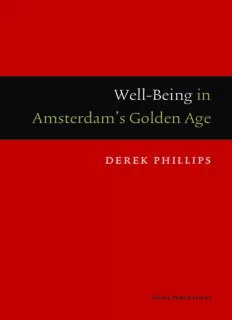
Well-Being in Amsterdam's Golden Age PDF
Preview Well-Being in Amsterdam's Golden Age
As human beings, we have an innate disposition to care about our well-being. (cid:59) We all care about staying alive, as well as about avoiding disease, physical pain, (cid:72) (cid:79) bodily harm, disability, and assaults on our dignity. Adequate nourishment, (cid:79) (cid:17) (cid:38) water, shelter, security, satisfying work, autonomy, and self-esteem are (cid:72) everywhere essential to human life and functioning. So, too, are relationships (cid:76)(cid:81) with others. These include giving and receiving care, loving and being loved. (cid:74) (cid:4) (cid:76) Our well-being matters for its own sake. (cid:81) (cid:4) (cid:37) (cid:80) The book’s major aim is to compare the well-being of people differing in civic (cid:59)(cid:72)(cid:79)(cid:79)(cid:17)(cid:38)(cid:72)(cid:76)(cid:81)(cid:74)(cid:4)(cid:76)(cid:81) (cid:86) status, economic standing, and gender during Amsterdam’s Golden Age. (cid:87) (cid:72) A secondary aim is to identify, describe, and explain the mechanisms linking (cid:85) (cid:71) people’s positions in these three systems of inequality to the wellness of (cid:68) (cid:37)(cid:80)(cid:86)(cid:87)(cid:72)(cid:85)(cid:71)(cid:68)(cid:80)(cid:161)(cid:86)(cid:4)(cid:43)(cid:82)(cid:79)(cid:71)(cid:72)(cid:81)(cid:4)(cid:37)(cid:74)(cid:72)(cid:4) (cid:80) their being. (cid:161) (cid:86) (cid:4) (cid:43) Utilizing a multidisciplinary perspective, the book draws on studies by (cid:82) (cid:79) historians, economists, demographers, sociologists, epidemiologists, biologists, (cid:71) (cid:72) and other scholars in showing how people’s hierarchical positions affected (cid:81) (cid:71)(cid:72)(cid:85)(cid:72)(cid:78)(cid:4)(cid:83)(cid:75)(cid:76)(cid:79)(cid:79)(cid:76)(cid:83)(cid:86) their well-being across the life-span. Their impact is considered during (cid:4)(cid:37) infancy, childhood, adolescence, adulthood, and old age, for the unmarried, the (cid:74) (cid:72) never-married, the married, the widowed, and the orphaned. This conceptual (cid:4) and historical analysis deepens our understanding of the processes linking (cid:71) inequality and well-being not only in seventeenth-century Amsterdam but in (cid:72) other times and places as well. (cid:85) (cid:72) (cid:78) (cid:4) (cid:83) (cid:75) (cid:76) (cid:79) (cid:79) (cid:76) (cid:83) (cid:86) www.aup.nl P P 9 789085 550426 P P WELL-BEING IN AMSTERDAM’S GOLDEN AGE WELL-BEING IN AMSTERDAM’S GOLDEN AGE Derek Phillips pallas publications Cover: Geert de Koning, Ten Post Lay-out: ProGrafi ci, Goes isbn 978 90 8555 042 6 nur 685/694 © Derek Phillips / Amsterdam University Press / Pallas Publications, Amsterdam 2008 All rights reserved. Without limiting the rights under copyright reserved above, no part of this book may be reproduced, stored in or introduced into a retrieval system, or transmitted, in any form or by any means (electronic, mechanical, photocopying, recording or otherwise) without the written permission of both the copyright owner and the author of the book. ONCE AGAIN, FOR KLASKE CONTENTS acknowledgements 9 introduction 11 1 chapter 25 In Their Proper Place: The Civic Hierarchy chapter 2 41 Gradients of Wealth and Income: The Economic Hierarchy chapter 3 59 At Home in Amsterdam: The Physical Environment and Early Death chapter 4 77 Intimate Inferiors: Servants in Amsterdam chapter 5 97 A Singular State: Unmarried Men and Women chapter 6 113 The Family Household: Husband, Wife, and Children chapter 7 131 Parents and Children, Brothers and Sisters chapter 8 149 Losing a Spouse and a Parent chapter 9 167 Losing Both Parents: Amsterdam Orphans 7 a summing up 185 notes 191 bibliography 233 the author 255 index 257 8 well-being in amsterdam’s golden age ACKNOWLEDGEMENTS A uthors of scholarly books inevitably incur debts, and acknowledge- ments are regularly made to those who helped them. Various foun- dations, funding agencies, and academic institutions are thanked for the fi nancial support which made the study possible. Appreciation is expressed for leave time, and teachers, students, and research assistants are thanked as well. There are words of gratitude for scholarly colleagues and friends who carefully read different versions of various chapters. Thanks are given to academic audiences to whom portions of the work were pre- sented in seminars and forums. Authors nowadays often compete to outdo one another in listing their accumulated debts. Pulling down a few books from my shelves, I see that one author lists travels to twenty libraries and archives, and dutifully thanks staff members in each. Another thanks academic audiences at more than a dozen distinguished universities for helpful remarks and comments, and then goes on to expresses gratitude to a long list of hosts and hostesses, mentioning the food and drink they shared as well. One author lists eight different sources of fi nancial support. Anoth- er is eternally grateful for the help of twenty colleagues who read versions of different chapters, and is especially indebted to the seven scholars who read the fi nal manuscript. All too often, these acknowledgements strike me as self-promoting and as offering (perhaps unintentionally) a self-portrait of the author as a seasoned networker and academic entrepreneur. Virtually everyone thanks partners and family members. Not only spouse, children, and parents are mentioned by name, but sometimes siblings, nieces and nephews, and in-laws as well. So, too, are long-time friends. Increasingly, gratitude is also expressed to a helpful neighbor, the guys and gals at the gym, a jogging group, a hairdresser, and even a won- derful dog, cat, or, in a book I just opened, a parrot. In many books, an author’s list of effusive acknowledgments seems endless. This book has been largely a solitary labor, and I have accumulat- ed few debts. I would like to thank the following persons for helping me: Lionel Lewis, Robert Loudon, Maurice Punch, and, most especially, my wife, Klaske Muizelaar. 9
Description: